COIT20248 Information Systems Analysis and Design: Development Report
VerifiedAdded on 2023/06/12
|11
|2353
|111
Report
AI Summary
This report details the development of an information system for UNICEF Childcare, aimed at automating processes and resolving issues associated with the manual system currently in place. The report covers key aspects such as system requirements, including functional requirements like online payment and auto-order functionality, and non-functional requirements like device support and system security. A cost-benefit analysis is presented to justify the project's economic viability, and a project schedule, including a work breakdown structure and Gantt chart, outlines the project's timeline and milestones. The prototyping development method is chosen for its iterative approach, allowing for thorough testing and refinement. Furthermore, the report discusses various system information requirement investigation techniques, such as direct monitoring, questionnaire surveys, and documentation analysis, used to gather essential data for the project. The conclusion reflects on the knowledge gained in project management and system development methodologies, emphasizing the benefits of the proposed system for UNICEF Childcare.
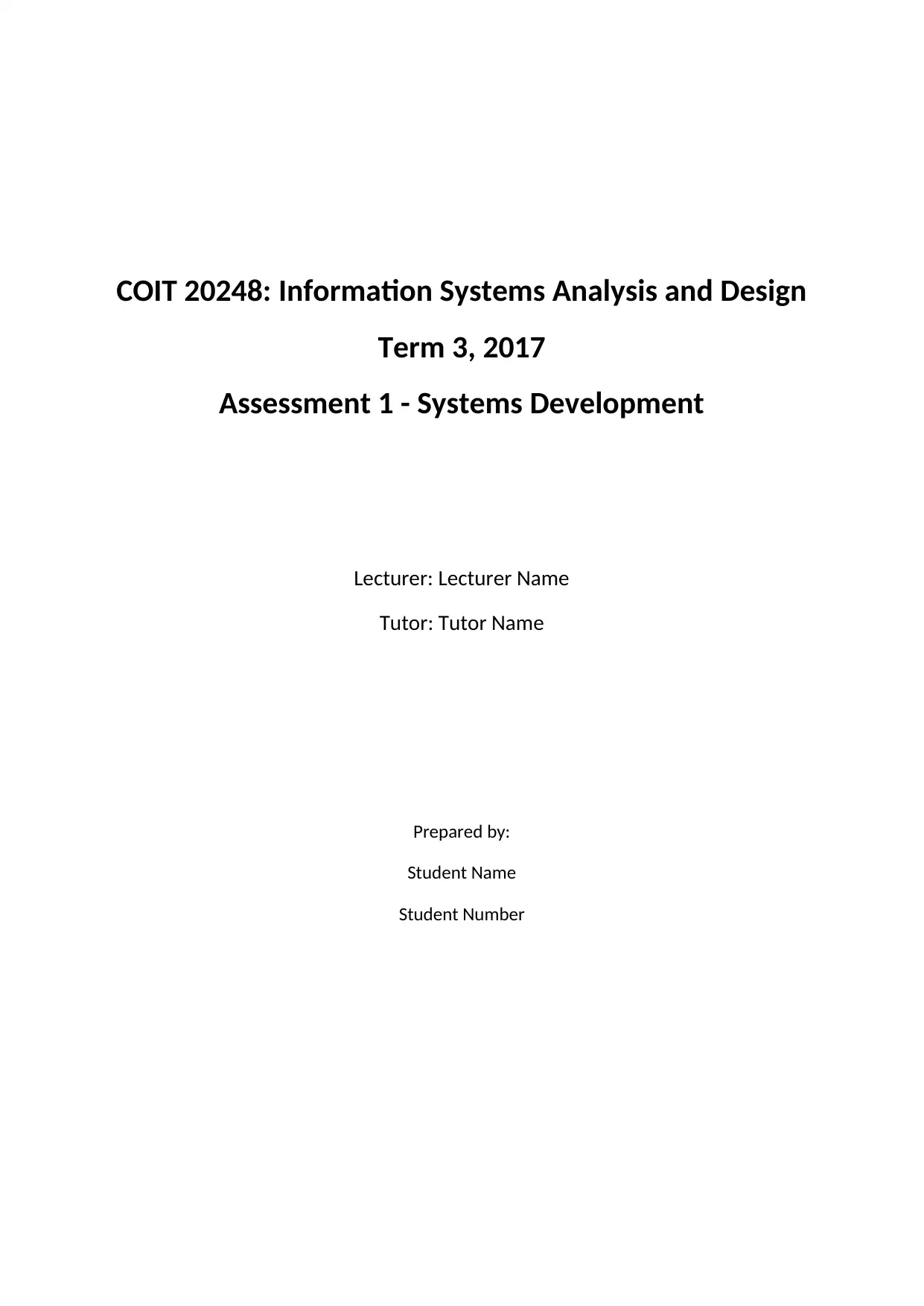
COIT 20248: Information Systems Analysis and Design
Term 3, 2017
Assessment 1 - Systems Development
Lecturer: Lecturer Name
Tutor: Tutor Name
Prepared by:
Student Name
Student Number
Term 3, 2017
Assessment 1 - Systems Development
Lecturer: Lecturer Name
Tutor: Tutor Name
Prepared by:
Student Name
Student Number
Paraphrase This Document
Need a fresh take? Get an instant paraphrase of this document with our AI Paraphraser
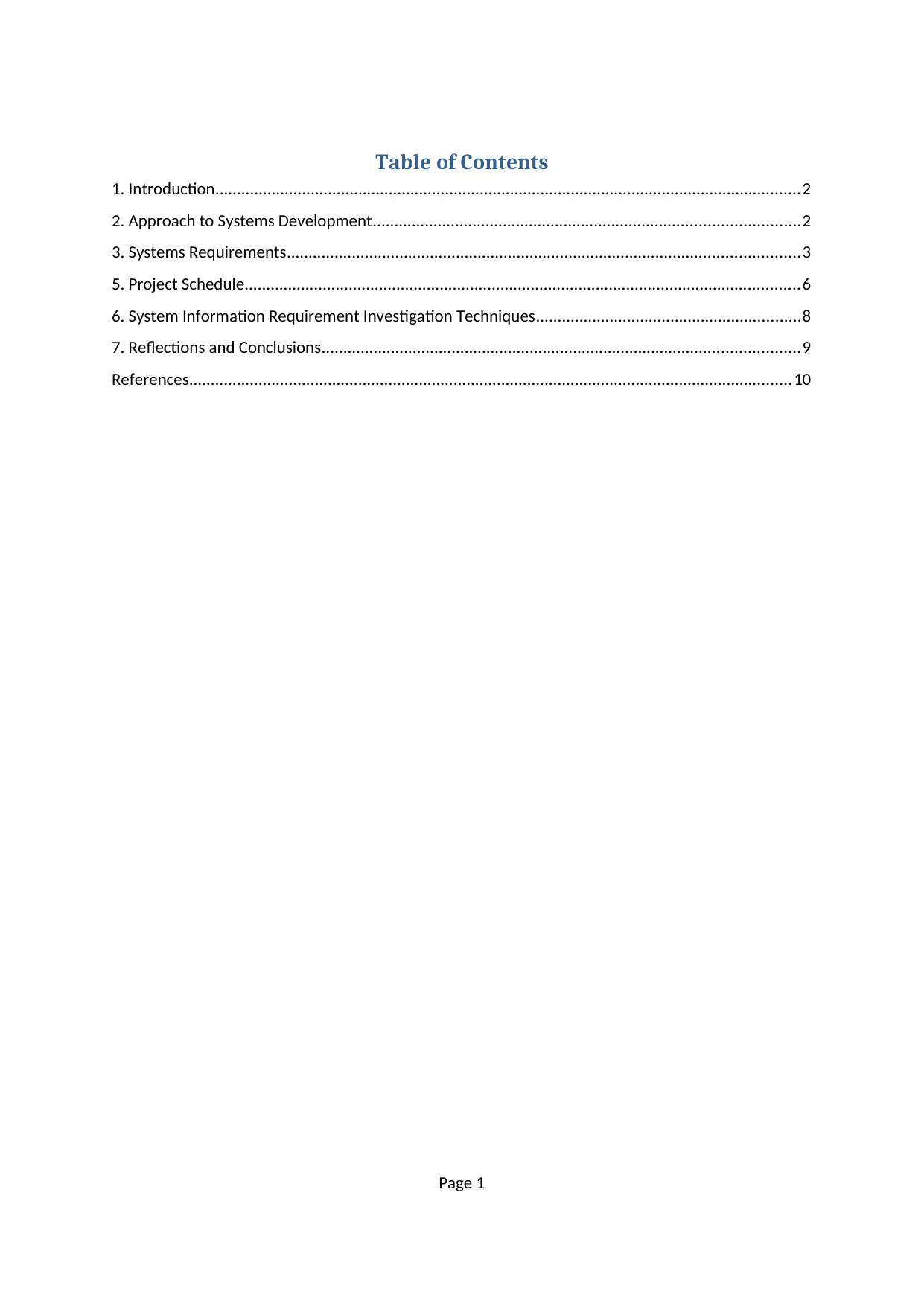
Table of Contents
1. Introduction.......................................................................................................................................2
2. Approach to Systems Development..................................................................................................2
3. Systems Requirements......................................................................................................................3
5. Project Schedule................................................................................................................................6
6. System Information Requirement Investigation Techniques.............................................................8
7. Reflections and Conclusions..............................................................................................................9
References...........................................................................................................................................10
Page 1
1. Introduction.......................................................................................................................................2
2. Approach to Systems Development..................................................................................................2
3. Systems Requirements......................................................................................................................3
5. Project Schedule................................................................................................................................6
6. System Information Requirement Investigation Techniques.............................................................8
7. Reflections and Conclusions..............................................................................................................9
References...........................................................................................................................................10
Page 1
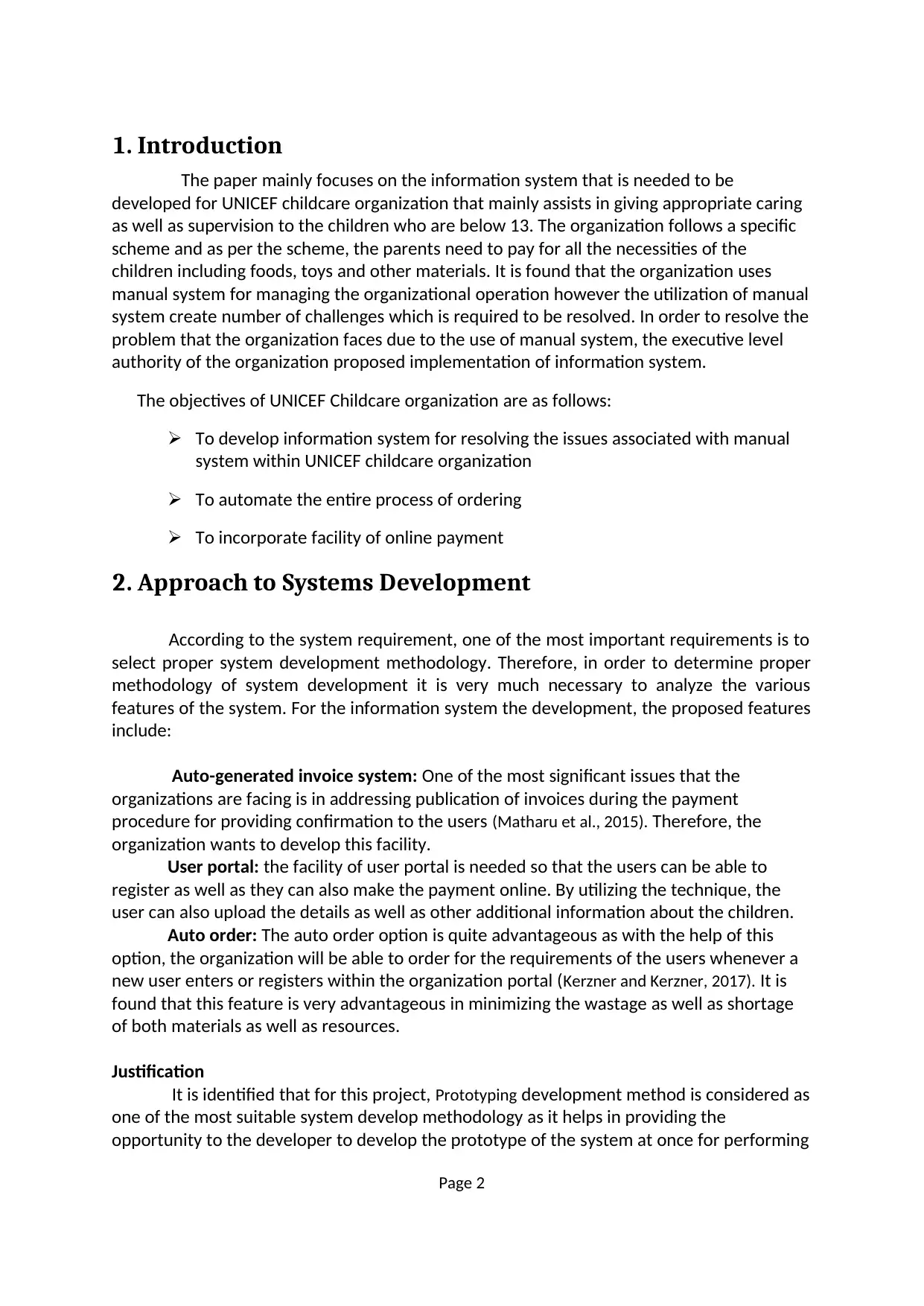
1. Introduction
The paper mainly focuses on the information system that is needed to be
developed for UNICEF childcare organization that mainly assists in giving appropriate caring
as well as supervision to the children who are below 13. The organization follows a specific
scheme and as per the scheme, the parents need to pay for all the necessities of the
children including foods, toys and other materials. It is found that the organization uses
manual system for managing the organizational operation however the utilization of manual
system create number of challenges which is required to be resolved. In order to resolve the
problem that the organization faces due to the use of manual system, the executive level
authority of the organization proposed implementation of information system.
The objectives of UNICEF Childcare organization are as follows:
To develop information system for resolving the issues associated with manual
system within UNICEF childcare organization
To automate the entire process of ordering
To incorporate facility of online payment
2. Approach to Systems Development
According to the system requirement, one of the most important requirements is to
select proper system development methodology. Therefore, in order to determine proper
methodology of system development it is very much necessary to analyze the various
features of the system. For the information system the development, the proposed features
include:
Auto-generated invoice system: One of the most significant issues that the
organizations are facing is in addressing publication of invoices during the payment
procedure for providing confirmation to the users (Matharu et al., 2015). Therefore, the
organization wants to develop this facility.
User portal: the facility of user portal is needed so that the users can be able to
register as well as they can also make the payment online. By utilizing the technique, the
user can also upload the details as well as other additional information about the children.
Auto order: The auto order option is quite advantageous as with the help of this
option, the organization will be able to order for the requirements of the users whenever a
new user enters or registers within the organization portal (Kerzner and Kerzner, 2017). It is
found that this feature is very advantageous in minimizing the wastage as well as shortage
of both materials as well as resources.
Justification
It is identified that for this project, Prototyping development method is considered as
one of the most suitable system develop methodology as it helps in providing the
opportunity to the developer to develop the prototype of the system at once for performing
Page 2
The paper mainly focuses on the information system that is needed to be
developed for UNICEF childcare organization that mainly assists in giving appropriate caring
as well as supervision to the children who are below 13. The organization follows a specific
scheme and as per the scheme, the parents need to pay for all the necessities of the
children including foods, toys and other materials. It is found that the organization uses
manual system for managing the organizational operation however the utilization of manual
system create number of challenges which is required to be resolved. In order to resolve the
problem that the organization faces due to the use of manual system, the executive level
authority of the organization proposed implementation of information system.
The objectives of UNICEF Childcare organization are as follows:
To develop information system for resolving the issues associated with manual
system within UNICEF childcare organization
To automate the entire process of ordering
To incorporate facility of online payment
2. Approach to Systems Development
According to the system requirement, one of the most important requirements is to
select proper system development methodology. Therefore, in order to determine proper
methodology of system development it is very much necessary to analyze the various
features of the system. For the information system the development, the proposed features
include:
Auto-generated invoice system: One of the most significant issues that the
organizations are facing is in addressing publication of invoices during the payment
procedure for providing confirmation to the users (Matharu et al., 2015). Therefore, the
organization wants to develop this facility.
User portal: the facility of user portal is needed so that the users can be able to
register as well as they can also make the payment online. By utilizing the technique, the
user can also upload the details as well as other additional information about the children.
Auto order: The auto order option is quite advantageous as with the help of this
option, the organization will be able to order for the requirements of the users whenever a
new user enters or registers within the organization portal (Kerzner and Kerzner, 2017). It is
found that this feature is very advantageous in minimizing the wastage as well as shortage
of both materials as well as resources.
Justification
It is identified that for this project, Prototyping development method is considered as
one of the most suitable system develop methodology as it helps in providing the
opportunity to the developer to develop the prototype of the system at once for performing
Page 2
⊘ This is a preview!⊘
Do you want full access?
Subscribe today to unlock all pages.

Trusted by 1+ million students worldwide
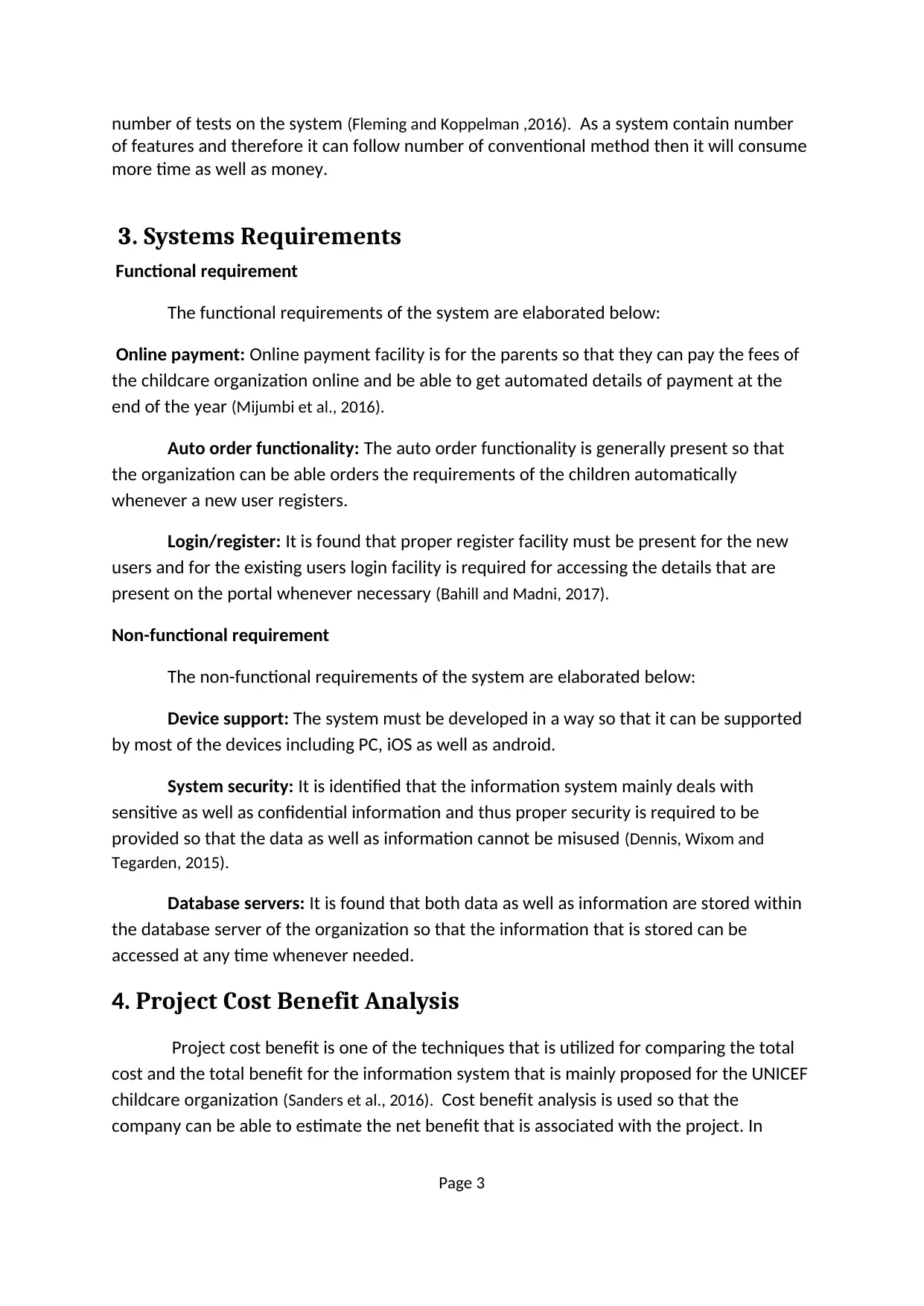
number of tests on the system (Fleming and Koppelman ,2016). As a system contain number
of features and therefore it can follow number of conventional method then it will consume
more time as well as money.
3. Systems Requirements
Functional requirement
The functional requirements of the system are elaborated below:
Online payment: Online payment facility is for the parents so that they can pay the fees of
the childcare organization online and be able to get automated details of payment at the
end of the year (Mijumbi et al., 2016).
Auto order functionality: The auto order functionality is generally present so that
the organization can be able orders the requirements of the children automatically
whenever a new user registers.
Login/register: It is found that proper register facility must be present for the new
users and for the existing users login facility is required for accessing the details that are
present on the portal whenever necessary (Bahill and Madni, 2017).
Non-functional requirement
The non-functional requirements of the system are elaborated below:
Device support: The system must be developed in a way so that it can be supported
by most of the devices including PC, iOS as well as android.
System security: It is identified that the information system mainly deals with
sensitive as well as confidential information and thus proper security is required to be
provided so that the data as well as information cannot be misused (Dennis, Wixom and
Tegarden, 2015).
Database servers: It is found that both data as well as information are stored within
the database server of the organization so that the information that is stored can be
accessed at any time whenever needed.
4. Project Cost Benefit Analysis
Project cost benefit is one of the techniques that is utilized for comparing the total
cost and the total benefit for the information system that is mainly proposed for the UNICEF
childcare organization (Sanders et al., 2016). Cost benefit analysis is used so that the
company can be able to estimate the net benefit that is associated with the project. In
Page 3
of features and therefore it can follow number of conventional method then it will consume
more time as well as money.
3. Systems Requirements
Functional requirement
The functional requirements of the system are elaborated below:
Online payment: Online payment facility is for the parents so that they can pay the fees of
the childcare organization online and be able to get automated details of payment at the
end of the year (Mijumbi et al., 2016).
Auto order functionality: The auto order functionality is generally present so that
the organization can be able orders the requirements of the children automatically
whenever a new user registers.
Login/register: It is found that proper register facility must be present for the new
users and for the existing users login facility is required for accessing the details that are
present on the portal whenever necessary (Bahill and Madni, 2017).
Non-functional requirement
The non-functional requirements of the system are elaborated below:
Device support: The system must be developed in a way so that it can be supported
by most of the devices including PC, iOS as well as android.
System security: It is identified that the information system mainly deals with
sensitive as well as confidential information and thus proper security is required to be
provided so that the data as well as information cannot be misused (Dennis, Wixom and
Tegarden, 2015).
Database servers: It is found that both data as well as information are stored within
the database server of the organization so that the information that is stored can be
accessed at any time whenever needed.
4. Project Cost Benefit Analysis
Project cost benefit is one of the techniques that is utilized for comparing the total
cost and the total benefit for the information system that is mainly proposed for the UNICEF
childcare organization (Sanders et al., 2016). Cost benefit analysis is used so that the
company can be able to estimate the net benefit that is associated with the project. In
Page 3
Paraphrase This Document
Need a fresh take? Get an instant paraphrase of this document with our AI Paraphraser
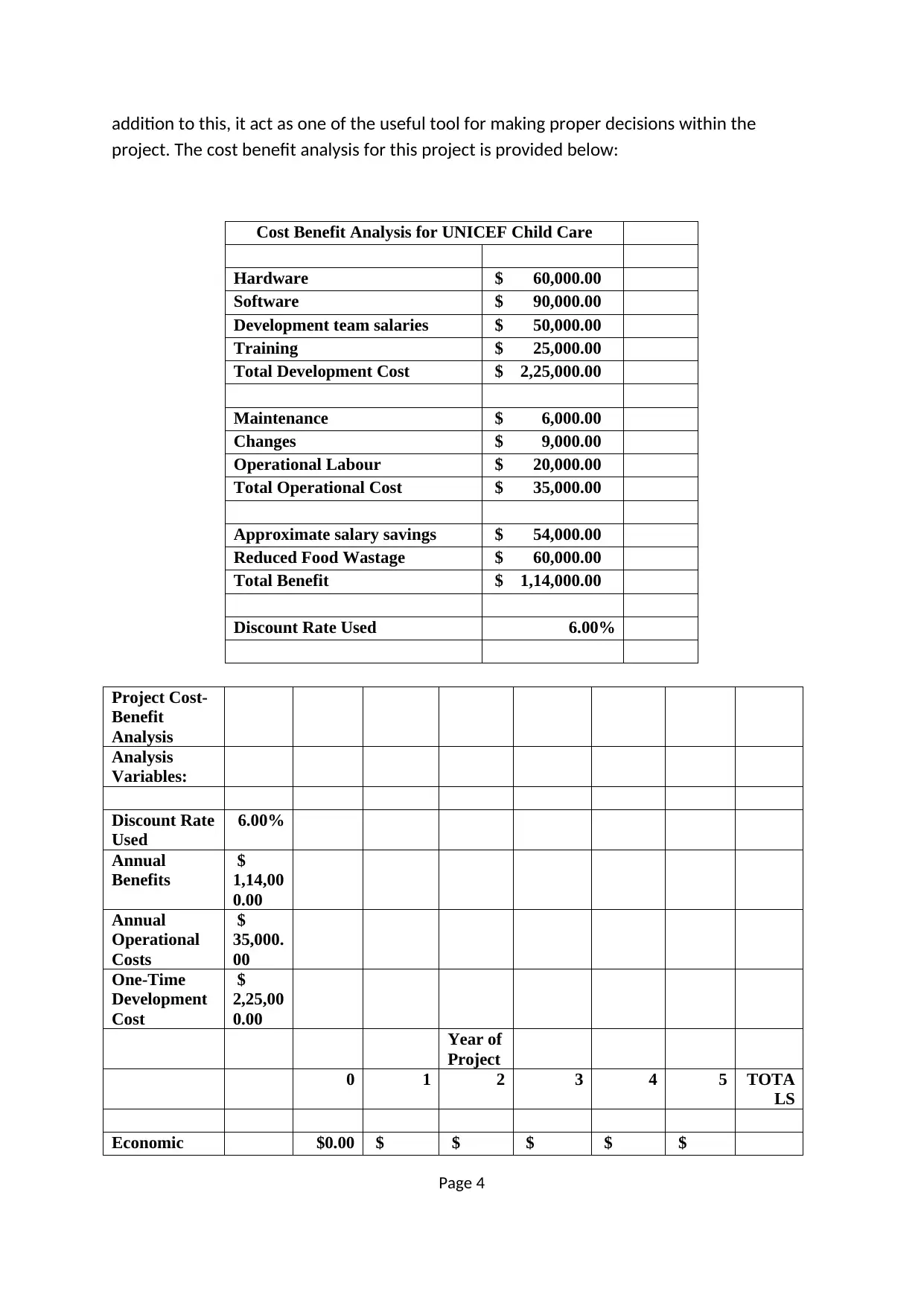
addition to this, it act as one of the useful tool for making proper decisions within the
project. The cost benefit analysis for this project is provided below:
Cost Benefit Analysis for UNICEF Child Care
Hardware $ 60,000.00
Software $ 90,000.00
Development team salaries $ 50,000.00
Training $ 25,000.00
Total Development Cost $ 2,25,000.00
Maintenance $ 6,000.00
Changes $ 9,000.00
Operational Labour $ 20,000.00
Total Operational Cost $ 35,000.00
Approximate salary savings $ 54,000.00
Reduced Food Wastage $ 60,000.00
Total Benefit $ 1,14,000.00
Discount Rate Used 6.00%
Project Cost-
Benefit
Analysis
Analysis
Variables:
Discount Rate
Used
6.00%
Annual
Benefits
$
1,14,00
0.00
Annual
Operational
Costs
$
35,000.
00
One-Time
Development
Cost
$
2,25,00
0.00
Year of
Project
0 1 2 3 4 5 TOTA
LS
Economic $0.00 $ $ $ $ $
Page 4
project. The cost benefit analysis for this project is provided below:
Cost Benefit Analysis for UNICEF Child Care
Hardware $ 60,000.00
Software $ 90,000.00
Development team salaries $ 50,000.00
Training $ 25,000.00
Total Development Cost $ 2,25,000.00
Maintenance $ 6,000.00
Changes $ 9,000.00
Operational Labour $ 20,000.00
Total Operational Cost $ 35,000.00
Approximate salary savings $ 54,000.00
Reduced Food Wastage $ 60,000.00
Total Benefit $ 1,14,000.00
Discount Rate Used 6.00%
Project Cost-
Benefit
Analysis
Analysis
Variables:
Discount Rate
Used
6.00%
Annual
Benefits
$
1,14,00
0.00
Annual
Operational
Costs
$
35,000.
00
One-Time
Development
Cost
$
2,25,00
0.00
Year of
Project
0 1 2 3 4 5 TOTA
LS
Economic $0.00 $ $ $ $ $
Page 4
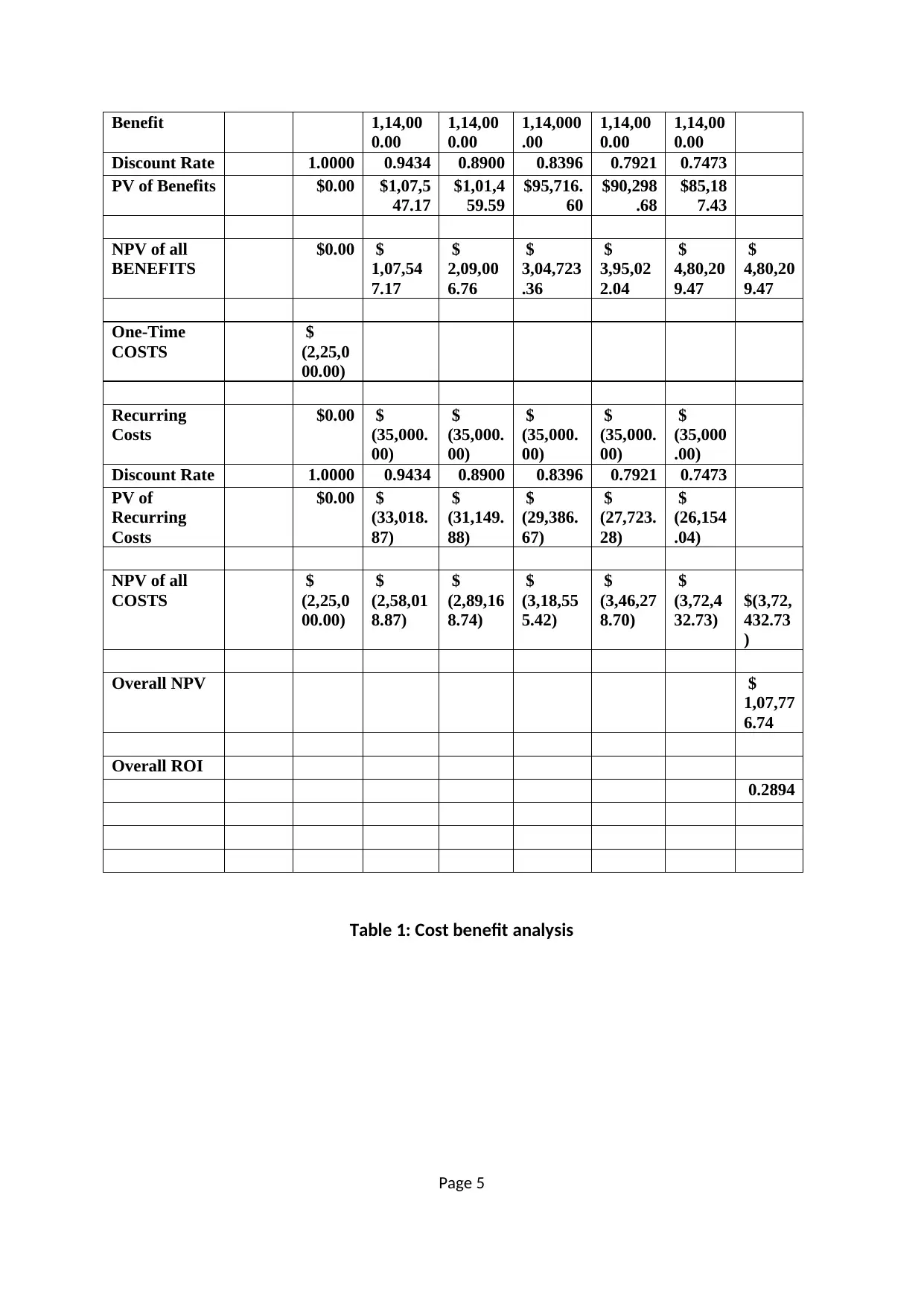
Benefit 1,14,00
0.00
1,14,00
0.00
1,14,000
.00
1,14,00
0.00
1,14,00
0.00
Discount Rate 1.0000 0.9434 0.8900 0.8396 0.7921 0.7473
PV of Benefits $0.00 $1,07,5
47.17
$1,01,4
59.59
$95,716.
60
$90,298
.68
$85,18
7.43
NPV of all
BENEFITS
$0.00 $
1,07,54
7.17
$
2,09,00
6.76
$
3,04,723
.36
$
3,95,02
2.04
$
4,80,20
9.47
$
4,80,20
9.47
One-Time
COSTS
$
(2,25,0
00.00)
Recurring
Costs
$0.00 $
(35,000.
00)
$
(35,000.
00)
$
(35,000.
00)
$
(35,000.
00)
$
(35,000
.00)
Discount Rate 1.0000 0.9434 0.8900 0.8396 0.7921 0.7473
PV of
Recurring
Costs
$0.00 $
(33,018.
87)
$
(31,149.
88)
$
(29,386.
67)
$
(27,723.
28)
$
(26,154
.04)
NPV of all
COSTS
$
(2,25,0
00.00)
$
(2,58,01
8.87)
$
(2,89,16
8.74)
$
(3,18,55
5.42)
$
(3,46,27
8.70)
$
(3,72,4
32.73)
$(3,72,
432.73
)
Overall NPV $
1,07,77
6.74
Overall ROI
0.2894
Table 1: Cost benefit analysis
Page 5
0.00
1,14,00
0.00
1,14,000
.00
1,14,00
0.00
1,14,00
0.00
Discount Rate 1.0000 0.9434 0.8900 0.8396 0.7921 0.7473
PV of Benefits $0.00 $1,07,5
47.17
$1,01,4
59.59
$95,716.
60
$90,298
.68
$85,18
7.43
NPV of all
BENEFITS
$0.00 $
1,07,54
7.17
$
2,09,00
6.76
$
3,04,723
.36
$
3,95,02
2.04
$
4,80,20
9.47
$
4,80,20
9.47
One-Time
COSTS
$
(2,25,0
00.00)
Recurring
Costs
$0.00 $
(35,000.
00)
$
(35,000.
00)
$
(35,000.
00)
$
(35,000.
00)
$
(35,000
.00)
Discount Rate 1.0000 0.9434 0.8900 0.8396 0.7921 0.7473
PV of
Recurring
Costs
$0.00 $
(33,018.
87)
$
(31,149.
88)
$
(29,386.
67)
$
(27,723.
28)
$
(26,154
.04)
NPV of all
COSTS
$
(2,25,0
00.00)
$
(2,58,01
8.87)
$
(2,89,16
8.74)
$
(3,18,55
5.42)
$
(3,46,27
8.70)
$
(3,72,4
32.73)
$(3,72,
432.73
)
Overall NPV $
1,07,77
6.74
Overall ROI
0.2894
Table 1: Cost benefit analysis
Page 5
⊘ This is a preview!⊘
Do you want full access?
Subscribe today to unlock all pages.

Trusted by 1+ million students worldwide
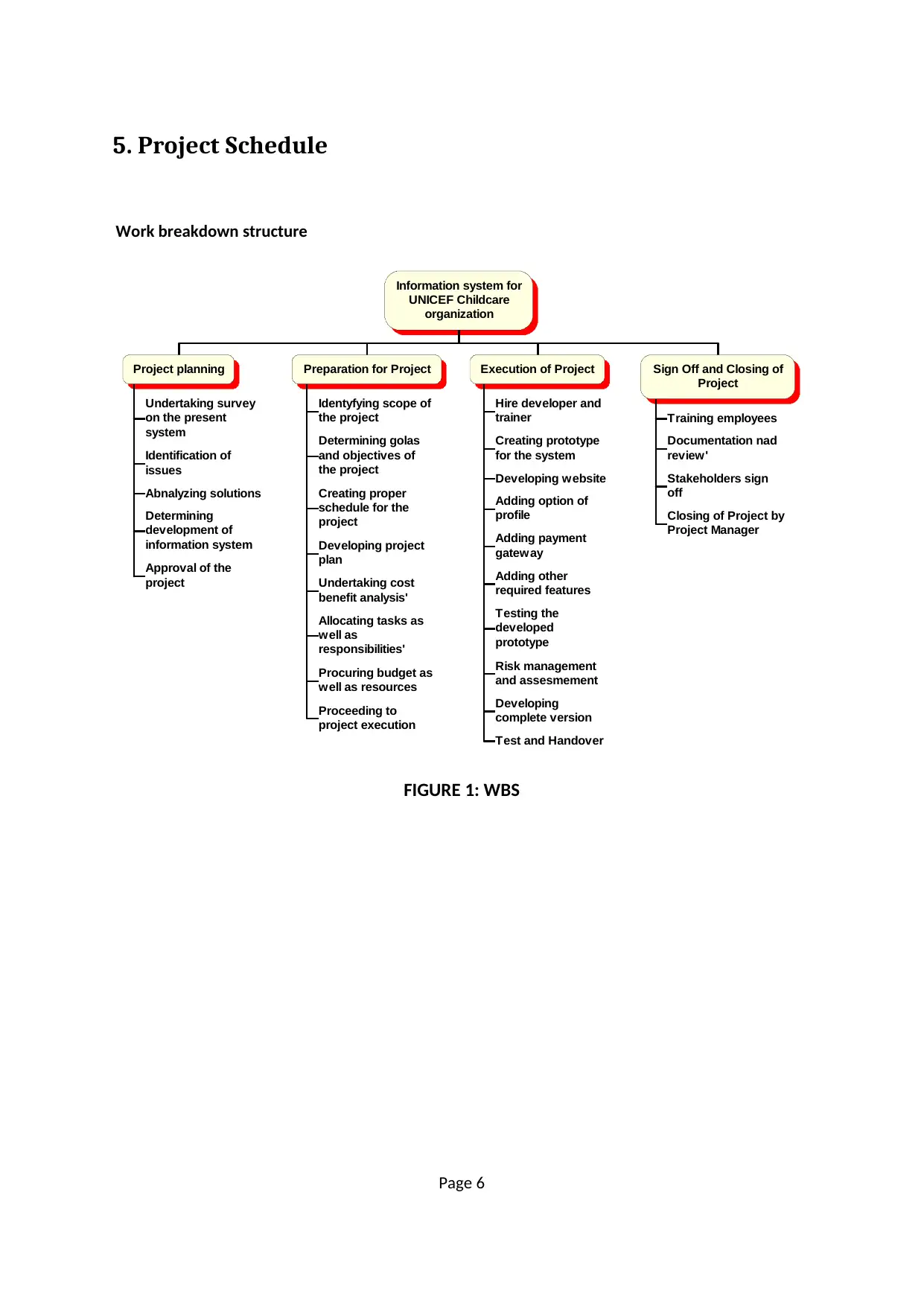
5. Project Schedule
Work breakdown structure
Information system for
UNICEF Childcare
organization
Project planning
Undertaking survey
on the present
system
Identification of
issues
Abnalyzing solutions
Determining
development of
information system
Approval of the
project
Preparation for Project
Identyfying scope of
the project
Determining golas
and objectives of
the project
Creating proper
schedule for the
project
Developing project
plan
Undertaking cost
benefit analysis'
Allocating tasks as
well as
responsibilities'
Procuring budget as
well as resources
Proceeding to
project execution
Execution of Project
Hire developer and
trainer
Creating prototype
for the system
Developing website
Adding option of
profile
Adding payment
gateway
Adding other
required features
Testing the
developed
prototype
Risk management
and assesmement
Developing
complete version
Test and Handover
Sign Off and Closing of
Project
Training employees
Documentation nad
review'
Stakeholders sign
off
Closing of Project by
Project Manager
FIGURE 1: WBS
Page 6
Work breakdown structure
Information system for
UNICEF Childcare
organization
Project planning
Undertaking survey
on the present
system
Identification of
issues
Abnalyzing solutions
Determining
development of
information system
Approval of the
project
Preparation for Project
Identyfying scope of
the project
Determining golas
and objectives of
the project
Creating proper
schedule for the
project
Developing project
plan
Undertaking cost
benefit analysis'
Allocating tasks as
well as
responsibilities'
Procuring budget as
well as resources
Proceeding to
project execution
Execution of Project
Hire developer and
trainer
Creating prototype
for the system
Developing website
Adding option of
profile
Adding payment
gateway
Adding other
required features
Testing the
developed
prototype
Risk management
and assesmement
Developing
complete version
Test and Handover
Sign Off and Closing of
Project
Training employees
Documentation nad
review'
Stakeholders sign
off
Closing of Project by
Project Manager
FIGURE 1: WBS
Page 6
Paraphrase This Document
Need a fresh take? Get an instant paraphrase of this document with our AI Paraphraser
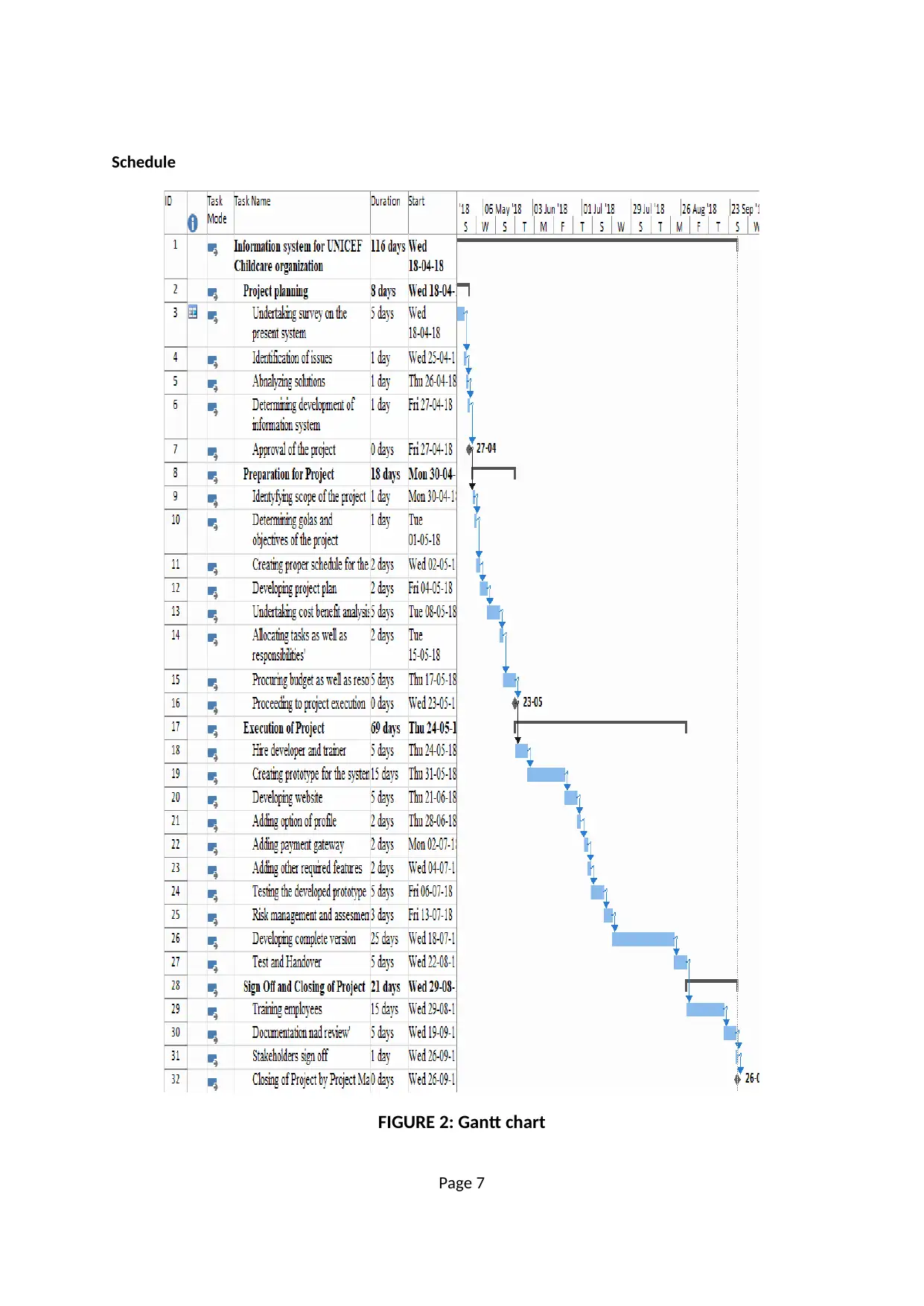
Schedule
FIGURE 2: Gantt chart
Page 7
FIGURE 2: Gantt chart
Page 7
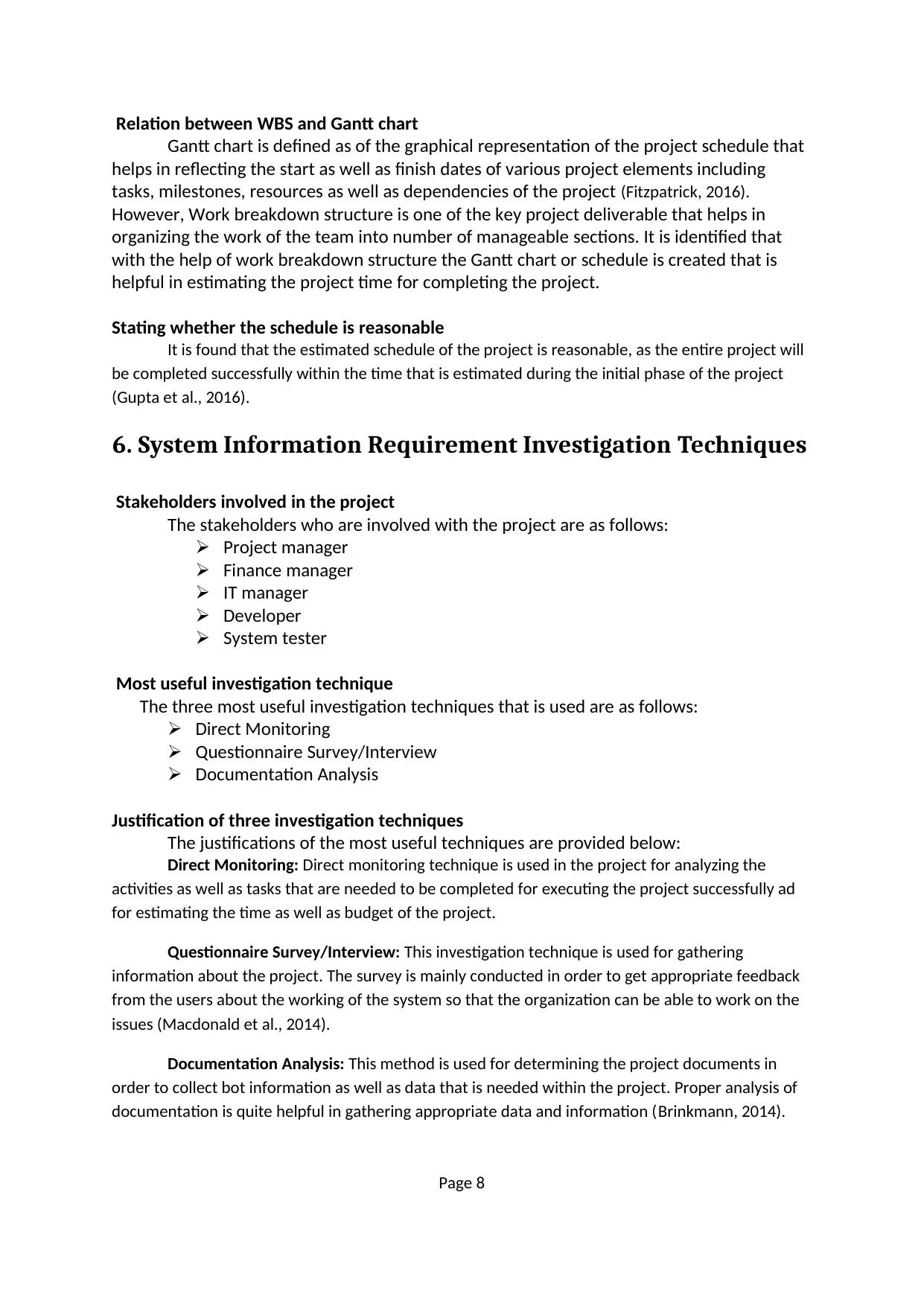
Relation between WBS and Gantt chart
Gantt chart is defined as of the graphical representation of the project schedule that
helps in reflecting the start as well as finish dates of various project elements including
tasks, milestones, resources as well as dependencies of the project (Fitzpatrick, 2016).
However, Work breakdown structure is one of the key project deliverable that helps in
organizing the work of the team into number of manageable sections. It is identified that
with the help of work breakdown structure the Gantt chart or schedule is created that is
helpful in estimating the project time for completing the project.
Stating whether the schedule is reasonable
It is found that the estimated schedule of the project is reasonable, as the entire project will
be completed successfully within the time that is estimated during the initial phase of the project
(Gupta et al., 2016).
6. System Information Requirement Investigation Techniques
Stakeholders involved in the project
The stakeholders who are involved with the project are as follows:
Project manager
Finance manager
IT manager
Developer
System tester
Most useful investigation technique
The three most useful investigation techniques that is used are as follows:
Direct Monitoring
Questionnaire Survey/Interview
Documentation Analysis
Justification of three investigation techniques
The justifications of the most useful techniques are provided below:
Direct Monitoring: Direct monitoring technique is used in the project for analyzing the
activities as well as tasks that are needed to be completed for executing the project successfully ad
for estimating the time as well as budget of the project.
Questionnaire Survey/Interview: This investigation technique is used for gathering
information about the project. The survey is mainly conducted in order to get appropriate feedback
from the users about the working of the system so that the organization can be able to work on the
issues (Macdonald et al., 2014).
Documentation Analysis: This method is used for determining the project documents in
order to collect bot information as well as data that is needed within the project. Proper analysis of
documentation is quite helpful in gathering appropriate data and information (Brinkmann, 2014).
Page 8
Gantt chart is defined as of the graphical representation of the project schedule that
helps in reflecting the start as well as finish dates of various project elements including
tasks, milestones, resources as well as dependencies of the project (Fitzpatrick, 2016).
However, Work breakdown structure is one of the key project deliverable that helps in
organizing the work of the team into number of manageable sections. It is identified that
with the help of work breakdown structure the Gantt chart or schedule is created that is
helpful in estimating the project time for completing the project.
Stating whether the schedule is reasonable
It is found that the estimated schedule of the project is reasonable, as the entire project will
be completed successfully within the time that is estimated during the initial phase of the project
(Gupta et al., 2016).
6. System Information Requirement Investigation Techniques
Stakeholders involved in the project
The stakeholders who are involved with the project are as follows:
Project manager
Finance manager
IT manager
Developer
System tester
Most useful investigation technique
The three most useful investigation techniques that is used are as follows:
Direct Monitoring
Questionnaire Survey/Interview
Documentation Analysis
Justification of three investigation techniques
The justifications of the most useful techniques are provided below:
Direct Monitoring: Direct monitoring technique is used in the project for analyzing the
activities as well as tasks that are needed to be completed for executing the project successfully ad
for estimating the time as well as budget of the project.
Questionnaire Survey/Interview: This investigation technique is used for gathering
information about the project. The survey is mainly conducted in order to get appropriate feedback
from the users about the working of the system so that the organization can be able to work on the
issues (Macdonald et al., 2014).
Documentation Analysis: This method is used for determining the project documents in
order to collect bot information as well as data that is needed within the project. Proper analysis of
documentation is quite helpful in gathering appropriate data and information (Brinkmann, 2014).
Page 8
⊘ This is a preview!⊘
Do you want full access?
Subscribe today to unlock all pages.

Trusted by 1+ million students worldwide
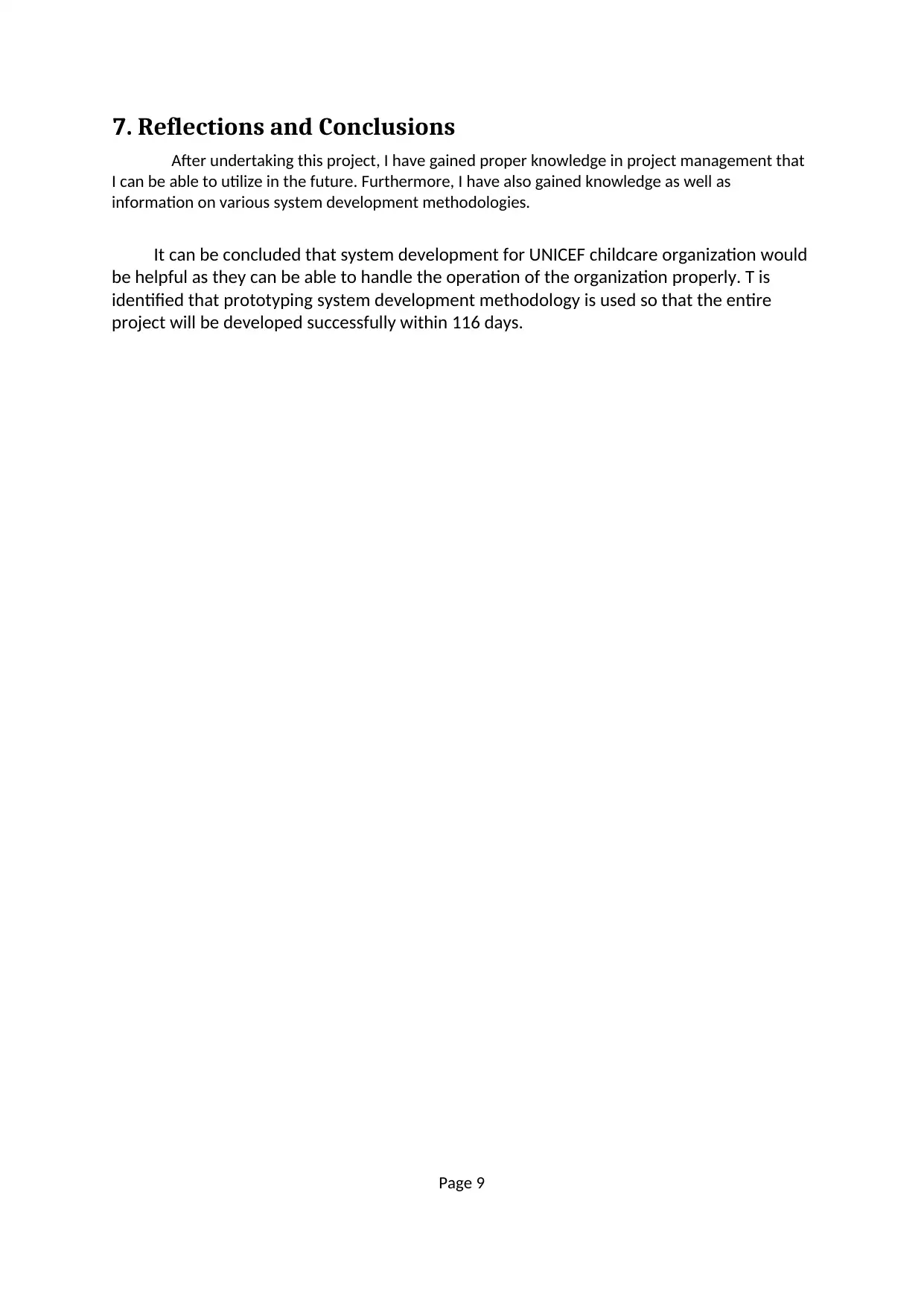
7. Reflections and Conclusions
After undertaking this project, I have gained proper knowledge in project management that
I can be able to utilize in the future. Furthermore, I have also gained knowledge as well as
information on various system development methodologies.
It can be concluded that system development for UNICEF childcare organization would
be helpful as they can be able to handle the operation of the organization properly. T is
identified that prototyping system development methodology is used so that the entire
project will be developed successfully within 116 days.
Page 9
After undertaking this project, I have gained proper knowledge in project management that
I can be able to utilize in the future. Furthermore, I have also gained knowledge as well as
information on various system development methodologies.
It can be concluded that system development for UNICEF childcare organization would
be helpful as they can be able to handle the operation of the organization properly. T is
identified that prototyping system development methodology is used so that the entire
project will be developed successfully within 116 days.
Page 9
Paraphrase This Document
Need a fresh take? Get an instant paraphrase of this document with our AI Paraphraser
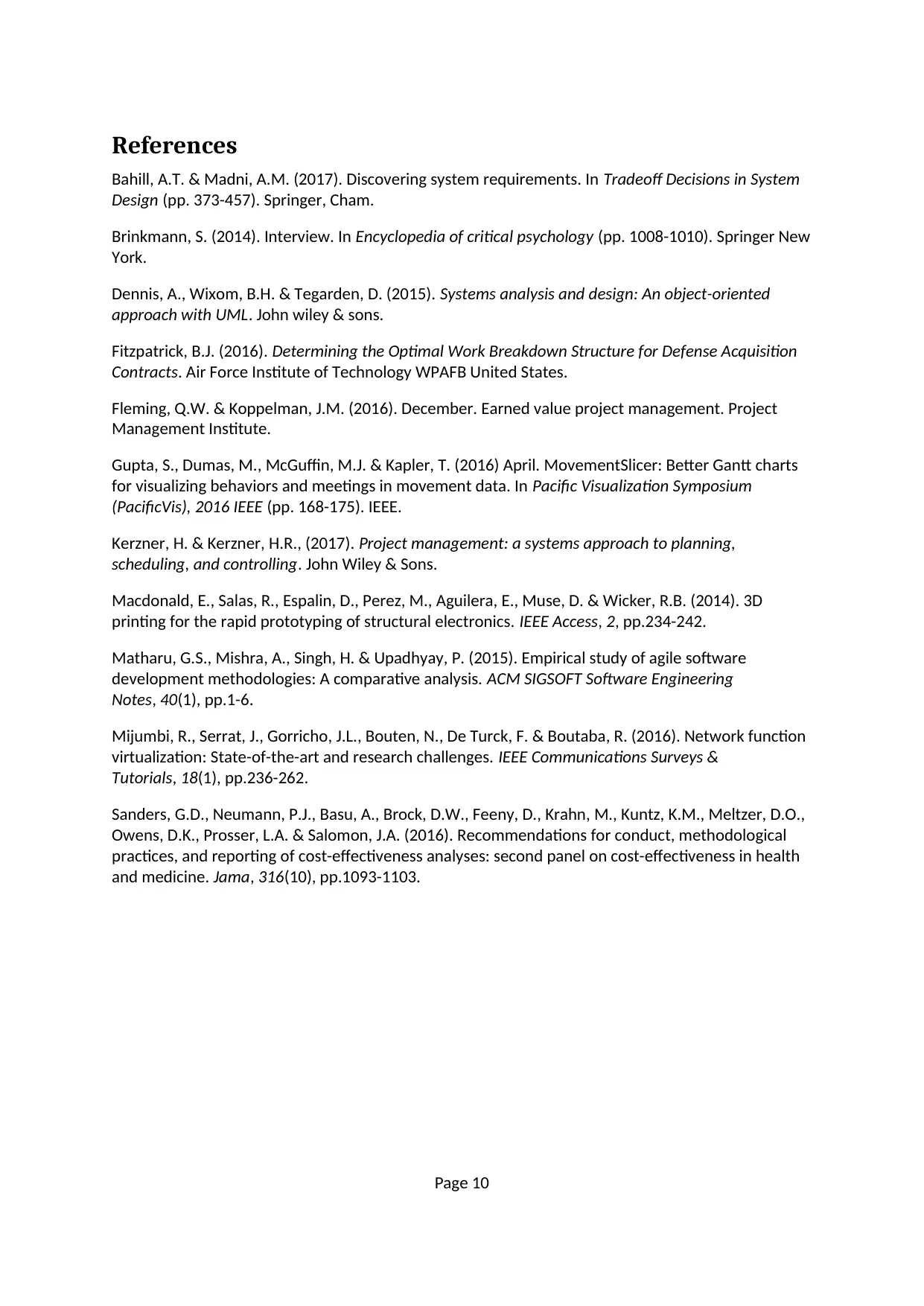
References
Bahill, A.T. & Madni, A.M. (2017). Discovering system requirements. In Tradeoff Decisions in System
Design (pp. 373-457). Springer, Cham.
Brinkmann, S. (2014). Interview. In Encyclopedia of critical psychology (pp. 1008-1010). Springer New
York.
Dennis, A., Wixom, B.H. & Tegarden, D. (2015). Systems analysis and design: An object-oriented
approach with UML. John wiley & sons.
Fitzpatrick, B.J. (2016). Determining the Optimal Work Breakdown Structure for Defense Acquisition
Contracts. Air Force Institute of Technology WPAFB United States.
Fleming, Q.W. & Koppelman, J.M. (2016). December. Earned value project management. Project
Management Institute.
Gupta, S., Dumas, M., McGuffin, M.J. & Kapler, T. (2016) April. MovementSlicer: Better Gantt charts
for visualizing behaviors and meetings in movement data. In Pacific Visualization Symposium
(PacificVis), 2016 IEEE (pp. 168-175). IEEE.
Kerzner, H. & Kerzner, H.R., (2017). Project management: a systems approach to planning,
scheduling, and controlling. John Wiley & Sons.
Macdonald, E., Salas, R., Espalin, D., Perez, M., Aguilera, E., Muse, D. & Wicker, R.B. (2014). 3D
printing for the rapid prototyping of structural electronics. IEEE Access, 2, pp.234-242.
Matharu, G.S., Mishra, A., Singh, H. & Upadhyay, P. (2015). Empirical study of agile software
development methodologies: A comparative analysis. ACM SIGSOFT Software Engineering
Notes, 40(1), pp.1-6.
Mijumbi, R., Serrat, J., Gorricho, J.L., Bouten, N., De Turck, F. & Boutaba, R. (2016). Network function
virtualization: State-of-the-art and research challenges. IEEE Communications Surveys &
Tutorials, 18(1), pp.236-262.
Sanders, G.D., Neumann, P.J., Basu, A., Brock, D.W., Feeny, D., Krahn, M., Kuntz, K.M., Meltzer, D.O.,
Owens, D.K., Prosser, L.A. & Salomon, J.A. (2016). Recommendations for conduct, methodological
practices, and reporting of cost-effectiveness analyses: second panel on cost-effectiveness in health
and medicine. Jama, 316(10), pp.1093-1103.
Page 10
Bahill, A.T. & Madni, A.M. (2017). Discovering system requirements. In Tradeoff Decisions in System
Design (pp. 373-457). Springer, Cham.
Brinkmann, S. (2014). Interview. In Encyclopedia of critical psychology (pp. 1008-1010). Springer New
York.
Dennis, A., Wixom, B.H. & Tegarden, D. (2015). Systems analysis and design: An object-oriented
approach with UML. John wiley & sons.
Fitzpatrick, B.J. (2016). Determining the Optimal Work Breakdown Structure for Defense Acquisition
Contracts. Air Force Institute of Technology WPAFB United States.
Fleming, Q.W. & Koppelman, J.M. (2016). December. Earned value project management. Project
Management Institute.
Gupta, S., Dumas, M., McGuffin, M.J. & Kapler, T. (2016) April. MovementSlicer: Better Gantt charts
for visualizing behaviors and meetings in movement data. In Pacific Visualization Symposium
(PacificVis), 2016 IEEE (pp. 168-175). IEEE.
Kerzner, H. & Kerzner, H.R., (2017). Project management: a systems approach to planning,
scheduling, and controlling. John Wiley & Sons.
Macdonald, E., Salas, R., Espalin, D., Perez, M., Aguilera, E., Muse, D. & Wicker, R.B. (2014). 3D
printing for the rapid prototyping of structural electronics. IEEE Access, 2, pp.234-242.
Matharu, G.S., Mishra, A., Singh, H. & Upadhyay, P. (2015). Empirical study of agile software
development methodologies: A comparative analysis. ACM SIGSOFT Software Engineering
Notes, 40(1), pp.1-6.
Mijumbi, R., Serrat, J., Gorricho, J.L., Bouten, N., De Turck, F. & Boutaba, R. (2016). Network function
virtualization: State-of-the-art and research challenges. IEEE Communications Surveys &
Tutorials, 18(1), pp.236-262.
Sanders, G.D., Neumann, P.J., Basu, A., Brock, D.W., Feeny, D., Krahn, M., Kuntz, K.M., Meltzer, D.O.,
Owens, D.K., Prosser, L.A. & Salomon, J.A. (2016). Recommendations for conduct, methodological
practices, and reporting of cost-effectiveness analyses: second panel on cost-effectiveness in health
and medicine. Jama, 316(10), pp.1093-1103.
Page 10
1 out of 11
Related Documents
Your All-in-One AI-Powered Toolkit for Academic Success.
+13062052269
info@desklib.com
Available 24*7 on WhatsApp / Email
![[object Object]](/_next/static/media/star-bottom.7253800d.svg)
Unlock your academic potential
Copyright © 2020–2025 A2Z Services. All Rights Reserved. Developed and managed by ZUCOL.





